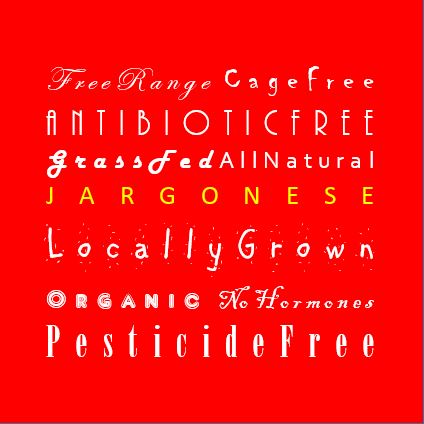Lately, the supermarket has become the go-to place for food “jargonese”. Food labels are getting harder and harder to decipher as food manufacturers whiz to the presses to change labels with the latest catch phrases and jargon.
Here’s a little quiz for you: (I know, I hate pop quizzes, too. Just bear with me.)
- Should you buy “free-range” or “cage-free”?
- What’s the difference between “all natural” and “organic”?
- Does it matter if something is “grass-fed” vs “grain-fed”?
Were you stumped by the jargonese OR did you ace the test? If any gave you pause, here’s a quick CHEAT SHEET!
CHICKEN & EGGS:
Cage-free: This refers to a bird that’s not raised in a cage. Elementary, I know. BUT, this area that the bird lives in could be a big area (wouldn’t we like to think that?) or it could be a small area with a lot of other animals. Also, cage-free does not guarantee that the area is outside–it could be in a dark, dank barn.
Free-range: This means the animal gets some sort of access to the outdoors. It could be for five minutes or it could be for an hour. There is no regulation.
Special Note: Neither cage-free or free-range affect the nutritional value of the food–only how the bird is treated before it reaches your dinner table. The term “ORGANIC” does affect the nutritional value of your food, however. ORGANIC means that the bird is reared on ORGANIC feed, is cage-free, and is free-range.
And One More Thing: Those pretty brown eggs are no different nutritionally than their white counterparts–unless the brown eggs have come from chickens fed an organic diet.
NATURAL VS ORGANIC:
OK. Let’s get really clear on this one. Labels like “all natural” don’t mean a darned thing–except that there’s no artificial flavors added. “Natural” is basically just a label created by food manufacturers to lure health-conscious customers to buy their product. Ugh!
Organic is where it’s at. If it’s organic AND locally-grown, even better. Scour your local farmer’s markets and co-ops!
BEEF & MILK:
No hormones: This basically means that growth hormones are not used to make the animal grow faster or to stimulate milk production in cows. Avoid hormone-fed animals and animal-products. However, please know that this does NOT mean that the milk you’re buying is 100%-free of hormones. Milk has a hormone called Insulin-like Growth Factor-1 (IGF-1) that is designed to make a calf into a cow in the matter of a few short months.
If IGF-1 stimulates this kind of growth in a calf, what does it do in the human body? You guessed it…IGF-1 stimulates growth of normal and abnormal (pre-cancerous) cells. In fact, IGF-1 is one of the leading factors posed by researchers for the link between ovarian and prostate cancers and dairy consumption.
Organic: If your meat or milk bears the label “organic”, then it’s hormone-free (not IGF-free), antibiotic-free and pesticide-free.
Special Note: GRASS-FED animals have a DIFFERENT nutritional profile than grain-fed meat. Grass-fed means better taste and a healthier fat profile–one that favors omega-3’s.
I hope this helps clear some of the supermarket confusion. Now that you know the difference between free-range, cage-free, all natural and organic, will you shop differently? I’d love to hear from you–post a comment right on my blog in the space provided below!


Recent Comments